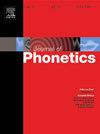个体天资对非本地元音生成超声生物反馈的影响
IF 2.4
1区 文学
0 LANGUAGE & LINGUISTICS
引用次数: 0
摘要
本研究旨在探讨个体的语言和空间知识对超声生物反馈训练效果的影响。我们还考察了元音差异对训练效果的影响,以及个体能力倾向与训练目标之间的相互作用。28名以台湾普通话为母语的人参与了非母语元音生成实验。参与者首先通过他们的语音意识、语音意识、体感敏锐度、生产变异性和空间推理来评估。参与者被训练发出非母语的粤语/音/和日语/音/,并提供超声生物反馈。广东话/音/和日语/音/分别在元音高度和元音前半部分上与普通话发音相近。每个元音的训练效果是通过比较训练前基线和训练后的舌头姿势(超声)来确定的。结果和发现有三个方面:第一,超声生物反馈训练在学习非母语声音的训练20分钟后可以有效。第二,元音高度维度的训练效果比元音正面维度的训练效果更强。最后,个体资质确实预测了超声生物反馈训练的有效性。个人能力和训练目标之间的相互作用可以通过共同的预测因素来调节,也可以通过对应于特定维度或特定于这些维度的预测因素来调节。本研究突出了超声训练效果与个体天资的关系,同时对训练对象的选择、放大训练效果的方法、训练效果的筛选试验等方面提供了新的见解。这些发现至关重要地为语音产生的理论框架和超声生物反馈的临床和教学应用提供了支持。本文章由计算机程序翻译,如有差异,请以英文原文为准。
Effects of individual aptitude on ultrasound biofeedback in non-native vowel production
The purpose of this study is to investigate how individual’s linguistic and spatial knowledge affects the training effects of ultrasound biofeedback. We also examined the influence of vowel differences on the training effect as well as the interaction between individual’s aptitude and training targets. Twenty-eight Taiwan Mandarin native speakers participated in the non-native vowel production experiment. Participants were first assessed by their phonetic awareness, phonological awareness, somatosensory acuity, production variability, and spatial reasoning. Participants were trained to produce non-native Cantonese /ɐ/ and Japanese /ɯ/, provided with ultrasound biofeedback. Cantonese /ɐ/ and Japanese /ɯ/ differ with their closest Mandarin counterparts in vowel height and frontness, respectively. The training effect for each vowel was determined by comparing the tongue postures (in ultrasound) between pre-training baseline and post-training performances. The results and findings are threefold: First, ultrasound biofeedback training in learning non-native sounds can be effective after 20 min of training. Second, more robust training effects were reported for the dimension of vowel height than vowel frontness. Last, individual aptitude indeed predicts the effectiveness of the ultrasound biofeedback training. The interaction between individual’s abilities and training targets can be modulated by common predictors, as well as by predictors that correspond to specific dimensions or are specific to those dimensions. This study highlights the relationship between ultrasound training effects and individual aptitude and at the same time provides insight with regards to the selection of training targets, the methods for magnifying training effect, and the screening test of training effect. These findings crucially lend support to both the theoretical framework of speech production and clinical as well as pedagogical application of ultrasound biofeedback.
求助全文
通过发布文献求助,成功后即可免费获取论文全文。
去求助
来源期刊

Journal of Phonetics
Multiple-
CiteScore
3.50
自引率
26.30%
发文量
49
期刊介绍:
The Journal of Phonetics publishes papers of an experimental or theoretical nature that deal with phonetic aspects of language and linguistic communication processes. Papers dealing with technological and/or pathological topics, or papers of an interdisciplinary nature are also suitable, provided that linguistic-phonetic principles underlie the work reported. Regular articles, review articles, and letters to the editor are published. Themed issues are also published, devoted entirely to a specific subject of interest within the field of phonetics.
 求助内容:
求助内容: 应助结果提醒方式:
应助结果提醒方式:


